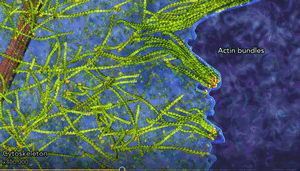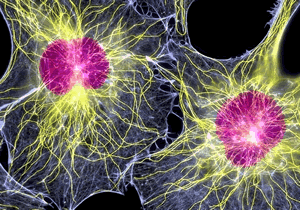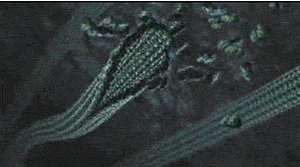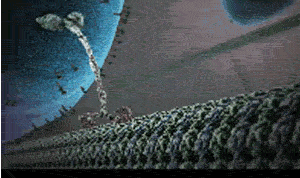
Microfilaments are composed predominantly of a contractile protein called actin. This protein along with myosin is responsible for muscle contraction. The cytoskeleton of fibroblasts is shown on the right the microtubules and microfilaments are visible after special staining. |

These microfilaments are also involved in cellular movement and internal transport. The cytoskeleton is a dynamic structure, parts are constantly assembled and disassembled. The animation on the right shows microtubules being assembled and disassembled in response to signals received.

Along these microtubules travel tiny organelles such as vesicles full of compounds that must be transported from organelle to organelle within the cell. Chromosomes are also moved along microtubules during cell division such as meiosis and mitosis Vesicles and other organelles are transported along these highways by special motor molecules. The animation on the right shows a vesicle being pulled along a microtubule by a molecular motor. |
The rapid transport of organelles, like mitochondria and vesicles that contain neurotransmitters, along the axons of nerve cells also takes place along microtubules. |

The video on the right shows a kinesin in motion. A kinesin is a protein belonging to a class of motor proteins found in eukaryotic cells. As shown in the video, kinesins move along microtubule filaments, and are powered by the hydrolysis of ATP. This active transport system of kinesins supports several cellular functions including mitosis, meiosis, where organelles and chromosomes are dragged to opposing sides of the cell and transport of large proteins in vesicles,such as neurotransmitters along a nerve fibre. Most kinesins move from the centre of the cell towards the periphery.
What is Brownian motion?
When a kinesin molecule binds to the microtubule is released.
Hydrolysis involves the breaking of bonds by the addition of water. ATP is hydrolysed to
View the video on the right to see the cytoskeleton in action in a living cell. Notice how this structure assists in cell movement and provides intracellular highways for the transport of vesicles containing organic material.